Suillus Adans.
A number of species are known in Europe. Fruitbody boletoid without or with partial veil, and then leaving a ring on the stipe. Cap in most species more or less viscid. Stipe solid.
Suillus sibiricus (Singer) Singer
Description
Fruitbody with partial veil, leaving more or less visible ring on the stipe. Cap up to 7 cm, at first hemispherical then expanding to convex, at first ivory, then yellowish to pale yellowish ochraceous, usually spotted violaceous brown or brownish, viscid when wet. Stipe, cylindrical, more or less dirty white, with more or less distinct ring, covered with numerous whitish to brownish glandular dots, basal mycelium pale pinkish. Flesh pale yellow to whitish. Tubes pale yellow to olivaceous yellow. Pores medium sized, angular, pale yellow to olivaceous yellow. Smell not distinctive. Taste acid. Spores 7–12 × 3.5–5 μm.
Habitat. Coniferous forests, sometimes artificial plantations, mycorrhizal with five-needled pines (Pinus cembra, P. peuce, P. strobus).
Distribution. In Europe rare, restricted to the range of its mycorrhizal hosts.
Photographs
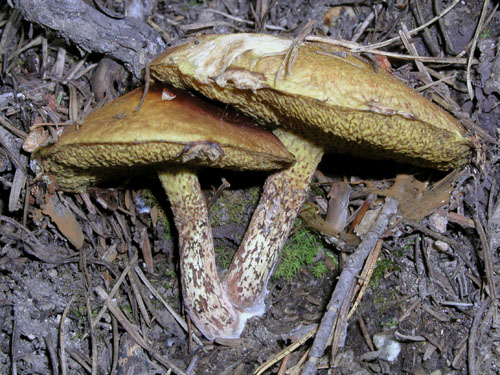
Mature fruitbodies of Suillus sibiricus. (photo B. Assyov)

Well developed fruitbodies of Suillus sibiricus. (photo B. Assyov)
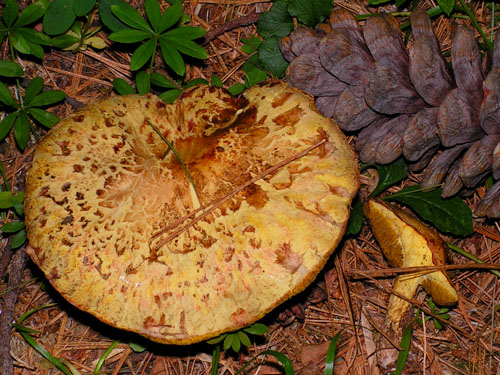
Fruitbodies of Suillus sibiricus. In the upper right corner part of the cone of the host tree (Pinus peuce) is seen. (photo B. Assyov)
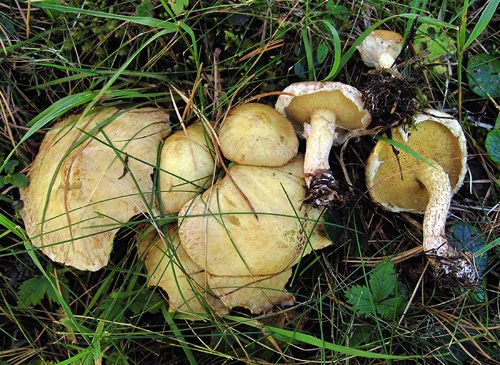
Rich collection of Suillus sibiricus. The disrupted partial veil is particularly well seen in this photograph. (photo G. Konstantinidis)
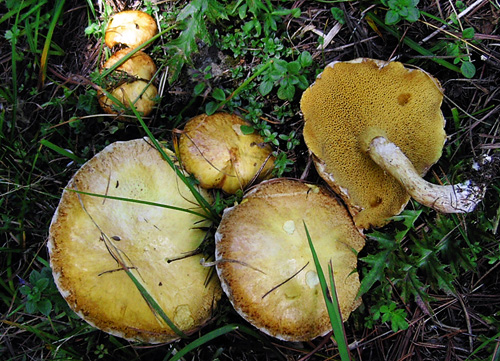
Fruitbodies of Suillus sibiricus. (photo G. Konstantinidis)
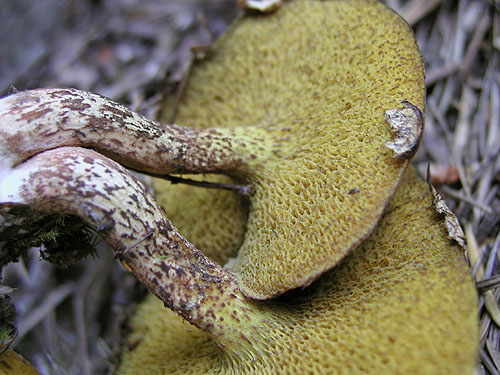
Suillus sibiricus. Note the prominent granules on the stipe and the large angular pores. (photo B. Assyov)
Important literature
Alessio, C.L. 1985. Boletus Dill. ex L. (sensu lato). – In: Fungi Europaei. Vol. 2. Pp. 1–705. Libreria editrice Biella Giovanna, Saronno.
Breitenbach J. & Kränzlin F. 1991. Pilze der Schweiz. Bd. 3(1). Röhrlinge und Blätterpilze. Verlag Mykologia, Luzern.
Engel, H., Dermek, A., Klofac, W., Ludwig, E. & Brückner, T. 1996. Schmier – und Filzröhrlinge s. l. in Europa. Die Gattungen Boletellus, Boletinus, Phylloporus, Suillus, Xerocomus. Verlag Heinz Engel, Weidhausen b. Coburg.
Estadès, A. & Lannoy, G. 2004. Les bolets européens. – Bulletin Mycologique et Botanique Dauphiné-Savoie 44(3): 3–79.
Galli, R. 1998. I Boleti. Atlante pratico-monographico per la determinazione dei boleti. Edinatura, Milano.
Lannoy, G. & Estadès, A. 2001. Les Bolets. Flore mycologique d’Europe. Documents Mycologiques Mémoire Hors série no. 6. Pp. 1–163. Association d’Écologie et de Mycologie, Lille.
Muñoz, J.A. 2005. Boletus s. l. – In: Fungi Europaei. Vol. 1. Pp. 1–951. Edizioni Candusso, Alassio.
Šutara, J., Mikšík, M. & Janda, V. 2009. Hřibovité houby. Čeled’ Boletaceae a rody Gyrodon, Gyroporus, Boletinus a Suillus. Academia, Praha.